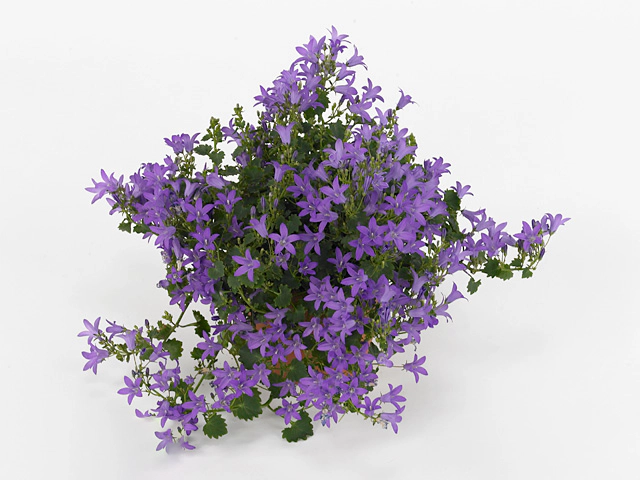Campanula portenschlagiana Jenny

| Flower type | Single |
| Leaf margin | Erose |
| Winter hardness | Good (USDA-zone 5, 6) |
| Flower color | Purple-medium blue violet-N087A |
| Soil fertility | No poor soils |
| Flower diameter | 2,5 - 3 cm |
| Plant height | 10 - 20 cm |
| Flower length/hight | 1 - 1,5 cm |
| Inflorescence | Raceme |
| Flowering month(s) | May; June; July; August |
| Leaf size | 2 - 3 cm |
| Light conditions | Semi-shades; Sunny |
| Leaf, main color | White |
| Flower color distribution | Unicolored |
| Moisture requirements | Well-drained |
The Campanula portenschlagiana Jenny, also known as Bellflower, is a beautiful flowering plant that adds a touch of elegance to any garden or landscape. With its stunning purple to medium blue-violet flowers, it is sure to capture the attention of all who see it.
One of the standout features of this plant is its single-flowered blooms. The flowers have a diameter ranging from 2.5 to 3 cm, making them small yet incredibly charming. They appear in abundance during the months of May, June, July, and August, creating a vibrant display of color.
The Campanula portenschlagiana Jenny is a compact plant, reaching a height between 10 and 20 cm. Its small stature makes it perfect for garden borders, rock gardens, or even container gardening. Despite its size, it offers a generous flower length of 1 to 1.5 cm, ensuring that the blooms remain visible and striking.
When it comes to light conditions, the Bellflower prefers semi-shade to sunny locations. It can adapt well to different light levels, making it suitable for a variety of garden settings. Additionally, its white main-colored leaves provide a lovely contrast against the vibrant purple-blue flowers, adding visual interest.
This plant also boasts good winter hardness, making it suitable for USDA zones 5 and 6. It can withstand colder temperatures and still thrive, making it an excellent choice for gardeners in these regions.
In terms of soil fertility, Campanula portenschlagiana Jenny prefers well-drained soil. While it can tolerate different soil types, it does not fare well in poor soils. Ensuring proper drainage and providing nutrients through organic matter or fertilizers will contribute to its overall health and vigor.
The Bellflower's inflorescence takes the form of a raceme, with flowers arranged along a central stem. This compact and organized arrangement further adds to its visual appeal. The plant's leaves have erose margins, creating a delicate and unique look.
Moisture-wise, the Campanula portenschlagiana Jenny prefers well-drained soil, as mentioned earlier. It is important not to overwater this plant, as excessive moisture can lead to root rot or other issues. Regular watering, allowing the soil to dry slightly between waterings, is optimal for its growth and development.
In conclusion, the Campanula portenschlagiana Jenny, or Bellflower, is an excellent choice for gardeners looking to add a splash of color to their landscape. With its stunning purple to medium blue-violet flowers, compact size, and overall hardiness, it is a versatile and beautiful plant. Whether used in borders, rock gardens, or containers, the Bellflower is sure to be a showstopper. With proper care, this plant will reward gardeners with its abundant blooms and charming presence for many seasons to come.
Market availability index by month:
| Jan. | Feb. | Mar. | Apr. | May | Jun. | Jul. | Aug. | Sep. | Oct. | Nov. | Dec. |
|---|---|---|---|---|---|---|---|---|---|---|---|
| 1 | 2 | 3 | 3 | 4 | 3 | 3 | 2 | 1 | 1 | 1 | 1 |